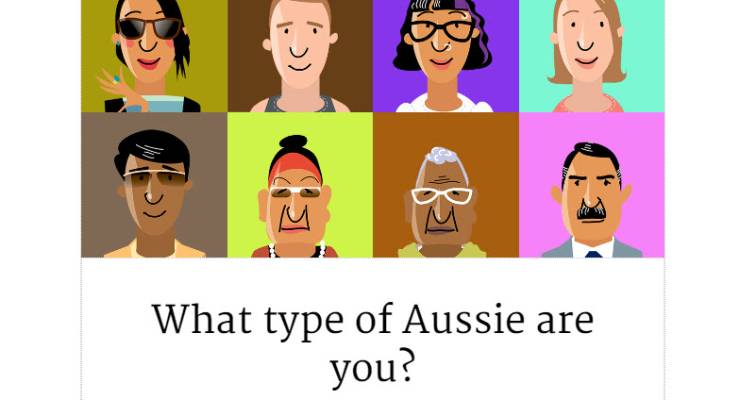
Throughout the Global South, the bodies of billions are devastated by trade and war. Across the West, workers are displaced and racists rise to power. Within Australia, neonationalist toddlers are throwing their toys into Parliament and out of the cot. And what is the response of our most storied media institutions to this era of chaos, inequality and violence? A quiz with cartoon illustrations. What is your “political persona”?!
Yesterday, the problems and effects of our time were reduced to a form of politico-astrology. Find out, urged the shareable headline, what kind of Aussie you are! Take our test to know where you stand on a political spectrum! I took the test. I learned nothing about myself, the nation or the world. I was reminded, however, of the lure of the Barnum Effect — a way to describe dodgy personality tests, such as Myer-Briggs, which have no function nobler than to award the respondent with a membership badge, so called because it refers to entertainment that delivers “something for everyone”.
It’s clickable, teachable, self-involved Oprah moments such as that unfolding to large audiences across Fairfax properties yesterday, which serve to remind we why I took out a Crikey subscription a decade ago. Do we always get our analysis of the era correct here? No. Do we pour our resources into some quasi-academic survey that seeks to say nothing more ambitious than “there’s no such thing as left and right anymore, and aren’t you special for knowing that!”. Hell no.
Complicated times demand complicated answers. Answers far more complicated than, “there are now SEVEN kinds of voter, instead of just two”. If there ever were just two kinds of voter in Australia, it was certainly before the time of Bob Santamaria, who knew there to be at least three.
[Why clickbait is killing Fairfax]
This “project”, which bears the imprimatur of the Australian National University, is the latest and most elaborate in a long line of declarations that “there is no such thing as right and left anymore! The divisions are blurred.” People say that as though this is news, and not the way voters, politicians and political philosophers have tended to behave at least since the age of the Jacobins. We’ve long had confusing debate about what constitutes political freedom from within particular movements. Karl Marx, granddaddy of the left, argued with trade unions. Milton Friedman, bastard of the financialised right, advocated for same-sex marriage. The brilliant and erratic Hannah Arendt changed and challenged her own political positions, sometimes within a single paragraph. If I read ONE MORE piece about how “left and right means nothing anymore!”, with the tedious conclusion always being that centrism is the only compromise and somehow, a form of democratic deliberation, I will, I will … well, I will probably just keep whining about it in Crikey.
Although this survey, first conducted on a sample group and now unleashed on Facebook, purports to describe the era using “science”, it fails to generate new knowledge just when we need it most. And that’s not just because its illustrated results now appear on social media alongside those of the “Which Buffy the Vampire Slayer Boss Villain are You?” quiz. I don’t mind the cutesy pictures and the cheap pop-culture approach. What I do mind are those assumptions built into the test questions, which spring from precisely the kind of centrist ideology so common at Fairfax.
There is this peculiar idea getting around that centrism is apolitical; that something that sees itself as a compromise between left and right is necessarily free of ideology. How can we believe that centrism is best after its most famous advocates, Bill Clinton and Tony Blair, are now largely remembered for their political obfuscation, and how can we believe it when centrist parties are being currently ejected from power in the West, in the directions of both left and right?
There’s a self-deluded centrist approach that can be easily seen in several of the questions. One question asks the respondent if they would be happy to sacrifice the value of their home if it meant greater housing affordability for all. Another asks if the respondent would “prefer” to save their money, or spend it all now. Another asks if weekly living costs are being cut back. All of these questions are, just like third-way policies were, based on the assumption that the citizen has wealth and assets about which they can make decisions.
On the question of housing affordability, there is great voter ignorance presupposed. During the last election, the ALP managed to claw back some of its territory precisely by describing to the people just who gets to determine housing prices. It’s not a secret, guys. We know it’s not us. We know it to be policies that favour investors. We know this is what forces 25% of the general population and close to 70% of Australian millennials to rent. I mean, come on. The Big Short was a very popular movie, and many of us have learned that we don’t individually determine a commodity price within a market, so why ask such a dumb question?
And why ask me about my “choice” to spend or save? It’s a fantasy question, asked by deluded centrists. One gainsaid by reports, also published by Fairfax itself. This week’s Household Financial Comfort Report showed the rapidly increasing divide in wealth in Australia. The historical tendency to capital accumulation is showing itself again. But, hey. Left and right mean nothing any more. The thing that matters, apparently, is a Barnum assessment of a voter’s ideas, not their material reality.
[Razer: white guilt and the individualised impotence of modern protest]
This is not good data. This is centrist garbage in and out. Not to assert my own “political persona” (that would be “historical materialist”, but they didn’t have a cartoon for it) but, if we are living in a nation where the growing number of people in the lowest income distribution are also the people experiencing the greatest income loss, don’t you think it’s time to have a bit less of a look at our values, and a bit more at our wallets?
This survey was designed to say that left and right mean nothing anymore. Even though these divisions are clearly now more meaningful in Europe than they have been in decades. I guess the guys who wrote this survey have not heard of Greece, a country that produced both Syriza and Golden Dawn. Actually, I guess these guys haven’t noticed the local rise of those who are both economically and culturally right. If the right means nothing anymore, I guess Cory Bernardi is just an unpleasant dream. And the default reality, as is so often the case at Fairfax, is centrism.
The imaginary centre. The fictional hub of deliberation. The delusion that political compromise is what will serve the people, or is what the people even imagine they want. If we keep producing knowledge and opinion from this false place, we will keep ignoring the very fact of political economies. This survey does nothing but support the ideology by which it was formed. The centre refuses to believe that it is the thing that will soon mean nothing anymore.








“They didn’t have a carton for it” fabulous typo to describe the quiz that puts voters into boxes. I want an historical materialist cartoon
From the article:
‘And Anti-Establishment Firebrands? Well they’re definitely the most likely to vote for Donald Trump if they had the chance.’
The notion that Trump or Bernadi or any of the new right-wing ‘firebrands’ are anti-establishment is completely farcical. It plays to the idea that that ‘there is no such thing as the left and right anymore’. What we are witnessing is a right-wing neo-nationalist insurgency against right-wing neoliberalism. The differences are largely rhetorical. They both represent the same establishment – corporate kleptocracy and war.
The quote I refer to is from the SMH ‘quiz’ article, not Helen’s of course.
Well played no chiefs. The new boss looks like a more pathological and stupid version of the old boss to me also. I would argue the differences are a bit more than rhetorical in that the new right-wing neo-nationalist insurgency are less concerned about being branded bigots and fools than the previous mob, and more inclined to get us all to hell quicker, but otherwise they do look like the same establishment.
That was around the point where I closed the tab on that article. For starters, there’s nothing anti-establishment about being really into national borders. Didn’t take the survey.
Thank God somebody is calling out this dog of a “survey” for what it is.
Thanks Helen!
Glad you had a go at this HR, I read briefly on my wood pulp-based version of the SMH, and found parts of myself belonging to 4 different groups and the whole to none at all, even remotely, but I didn’t go as far as to take the quiz.
I’m surprised at how big Myers-Briggs is still in the corporate world, given that it has been debunked so thoroughly. On anecdotal evidence only I’d say it is making a comeback.
Sounds like there weren’t any questions along the lines of ‘Are you in a good job earning good wages, where you aren’t under threat from being sacked tomorrow, and don’t suffer a wallet full of credit card debt and no hope of getting a mortgage, or paying one off if you had one? etc………
I ‘did the survey’. I was a bit surprised ANU put its name on this…..just because, well, what you describe in this piece is basically true, I think. From memory, one of the categories is ‘disillusioned’ or something like that…..I mean, this is meant to be an exercise in voting intelligence…..the disillusioned in US or even Australia may/may not even vote and may be expressing ‘their political capacity’ elsewhere on a day to day basis such as on the streets in the US….as you kind of say, a saccharine sweet centrist exercise at a time of extreme things in extreme new ways…..